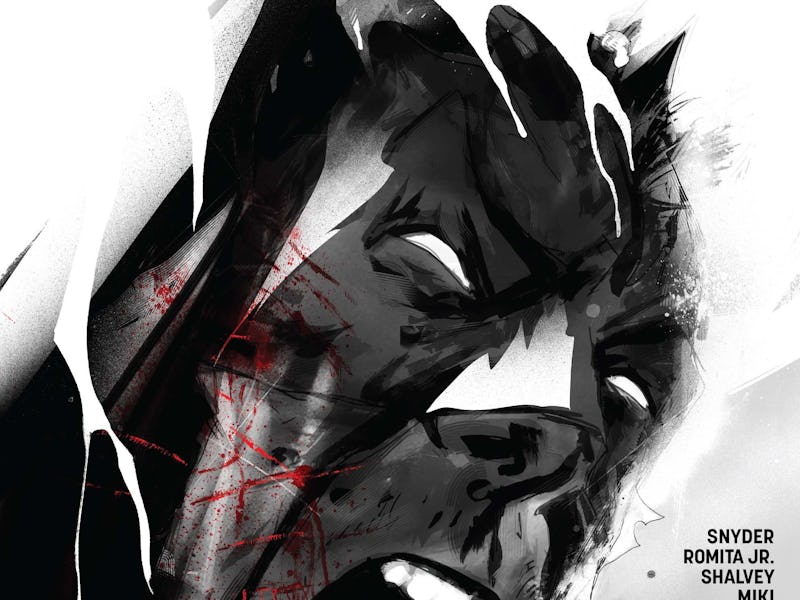To Scott Snyder, Batman Killing Villains Is a Huge Failure
"I understand in dark times, the impulse is to make your heroes darker. I’d argue the opposite," Snyder tells Inverse.

Scott Snyder has been writing definitive Batman comics for six years. In 2011, DC Entertainment nabbed him with an exclusive contract, and in the years since, he’s written Bruce Wayne’s stories in Detective Comics, Batman: Gates of Gotham, Batman, Talon (a Court of Owls spin-off), Batman Eternal, and most recently, Rebirth’s All-Star Batman. He’s overqualified to analyze who Batman is to the world, and when Inverse brought up the machine gun-toting Batfleck in Zack Snyder’s Justice League, he had a lot to say about the Dark Knight being a killer.
“I understand in dark times, the impulse is to make your heroes darker,” Snyder tells Inverse. “It seems that the correlation should be one to one. I’d argue the opposite. When things are more ominous, the brighter and more inspiring your heroes can become.”
So, what keeps a Batman writer from having him kill a villain? A belief in the rule?
The odd thing is, I can’t spoil anything, but I have a story coming … I won’t say which one it is, but in it, you see the consequences of that action. Batman can see what would happen if he did … some of those things.
I very much do think that there are stories with Batman killing that are intriguing — but for me, they’re always tragic. I don’t believe Batman would recover from killing a villain. It would be a huge dent and a failure in his history.
The DCU has turned Batman into a militaristic, brooding figure.
[In All-Star], we repositioned the villains to be extra potent regarding things in our atmosphere now. Two-Face represents a difference in ideological camps. Batman fights the final villain in the book at the Washington Monument, and he’s been accused, in this book, of fighting with lies. Batman says, “We’ll all be okay if we stick together,” and Ra’s al Ghul is saying, “No we won’t. The data shows that we won’t make it unless people die.” Essentially, he’s saying, “You’re the fake news, Batman”.
Meanwhile, our Freeze is connected to permafrost and climate change, and Poison Ivy is connected to plague and biological weapons. It all feels personally scary.
And yet Batman won’t kill them.
Though Batman doesn't murder, he's definitely a fan of torturing and maiming.
That would take everything away. As someone who’s written the character for a long time, I’ve got hundreds of requests to see Batman kill the Joker, to let that be the last story between them. The issue is: Everything is at stake in those moments. Not only does Batman live by a personal code (it’s really more of a set of ethics), he’s not a dark, vengeful character. He’s someone who’s a figure of inspiration. He says, “I am brave in the face of things that seem insurmountable, and I need you to be as well.”
Why wouldn’t it make more sense to take Two-Face and Joker off the table, considering how many people they’ve killed? Well, murder is all the villains want from Batman, they want to see him fall off his pedestal, and if he does, they win.
You told me once that Two-Face represents depression. Does that comparison hold true through the rest of this book?
We kept it fun and translated the concepts into comic book language, but yes, they’re supposed to relate to fears and demons I have. Two-Face is saying everybody is more villainous than you think, regardless of what side they’re on. He says we’re all selfish and have no desire to talk to each other. He represents the ugliness in the national and international discourse.
On the other side, Batman is saying regardless of what side you’re on or the challenges you face in life, you can find a way to believe in something bigger than you and come together to discuss and work things out.
Duke Thomas tells Batman “I can’t let you do that.” pretty often in All-Star. Do you think that’s how a sidekick should function?
I love that Duke belongs to a new generation of heroes. We have big plans for him. He’s sort of a Robin who doesn’t need a Batman to be a hero. He was trying to solve crossword puzzles to take down the Riddler on his own, and when Batman offered to help, he said, “No thanks, I got it.” There’s a fierce independence there.
We make heroes differently than we did once. The Bat Family traditionally goes out by night, but Duke is more grounded. He lives in the city, in Gotham, in a different way that Bruce does. Bruce looks down from a gargoyle and Duke actually knows these people.
Ultimately, it makes Duke more heroic for overcoming obstacles in his personal life. Bruce can sometimes be myopic; he just repeats, “I know you can be the best you can be. Follow me. We can do this.” But Duke says, “Okay, yes, I hear you, but you have to acknowledge and legitimize the fears other people voice, whether it’s about their anger or concern over things they face that you don’t.”
Duke’s role going forward is something I’m excited about. One of my goals this year with DC is to introduce some new talent through the teaching program. They’re all working on risky, new, fun things.
This interview has been edited for brevity and clarity.
All-Star Batman Vol 1 is available in stores now. Issue #10 hits stands May 14, 2017.